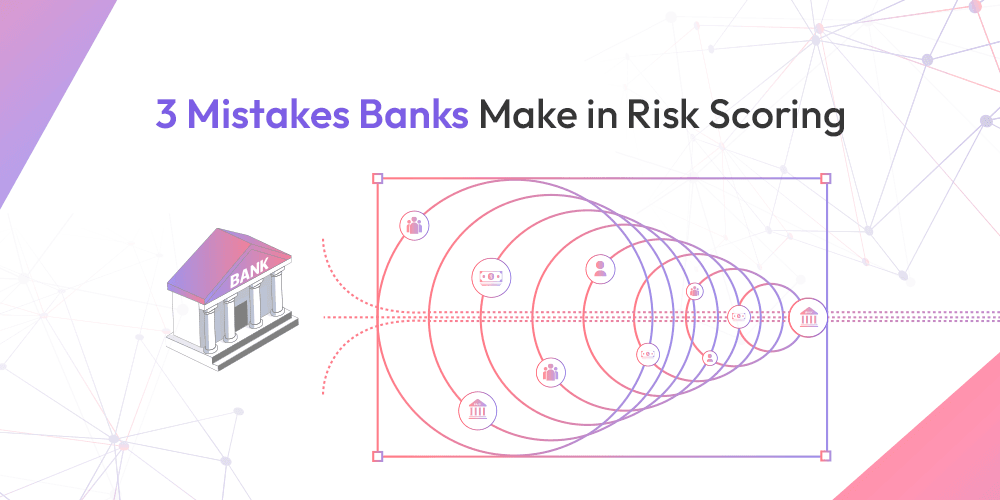
3 Mistakes Banks Make in Risk Scoring
RaptorX.ai
Wednesday, August 20, 2025
Summary:
Banks today face a growing challenge: fraudsters and money launderers operate faster, smarter, and in highly networked patterns. Static scoring thresholds and siloed systems simply cannot keep pace. The result is a dangerous mix of false positives, missed threats, and operational inefficiencies.
This paper identifies three recurring mistakes in bank risk scoring practices and proposes a new path forward. By moving from static rules to dynamic, adaptive scoring, breaking down silos through graph and network analysis, and enriching scores with behavioral and intent analysis, financial institutions can significantly strengthen their fraud and AML defenses.
1. Static and Rigid Scoring Methods
Many banks treat risk scoring as a one-time setup. Thresholds are defined based on transaction size, geography, or customer type, and rarely revisited. While this looks efficient, it creates rigidity that fraudsters exploit.
Why it Fails
- Criminals adapt faster than static thresholds.
- Behavioral shifts in payments (e.g., UPI, ACH, IMPS) remain undetected.
- First-time fraud or novel laundering patterns pass through unchallenged.
Example
A mule account may stay just under a $10,000 transaction limit repeatedly. A static model will never flag this. But with dynamic scoring that continuously monitors behavioral shifts and intent, the system would notice the unusual pattern over time.
A Better Approach
Dynamic, real-time risk scoring powered by agentic AI adapts continuously. It updates scores for every transaction, using behavior and intent analysis to reflect emerging threats instead of waiting for human intervention.
2. Treating Fraud, AML, and Cyber Risks in Silos
Banks often separate risk management into distinct areas, fraud, AML, and cyber, each with its own scoring system. While logical in structure, this creates fragmented intelligence.
Why it Fails
- Fraud and money laundering are rarely isolated; they are connected.
- Entity relationships (shared IPs, devices, merchants, or mule accounts) remain hidden.
- Teams drown in isolated alerts, unable to see the full picture.
Example
An account flagged for credential theft in a cyber incident may also act as a mule in laundering operations. A siloed system won’t connect these dots.
A Better Approach
Adopting a graph and network-based scoring model unifies intelligence across domains. Graph Neural Networks (GNNs) allow banks to see hidden relationships across entities, devices, accounts, or payments that traditional, siloed scoring cannot. This helps expose fraud rings, mule clusters, and synthetic IDs faster and with greater accuracy.
3. Oversimplified Risk Scores Without Context
Another mistake is compressing all complexity into a single, static score. While simple, this ignores the nuances of customer intent and transaction context.
Why it Fails
- High false positives overwhelm investigators.
- Genuine customers face friction, damaging trust.
- Sophisticated fraud still evades detection.
Example
Two customers make the same high-value transfer. A flat score flags both equally. But pattern and intent analysis could distinguish a legitimate remittance from layering in a laundering scheme, saving time and effort for investigators.
A Better Approach
Context-aware scoring integrates behavioral patterns, intent signals, and network relationships into risk evaluation. Instead of a flat number, investigators see explainable scores enriched with context, leading to fewer false positives and more precise detection.
The Way Forward: Smarter Risk Scoring
To overcome these challenges, financial institutions should focus on three guiding principles:
- Dynamic Scoring – Move from static thresholds to continuous, adaptive scoring that reflects real-time behavior and intent.
- Cross-Domain Intelligence – Break down silos with graph and network approaches to detect fraud across fraud, AML, and cyber domains.
- Contextual Analysis – Enhance scoring with behavior, pattern, and intent analysis for precise, explainable results.
By avoiding these three mistakes, banks can move toward a resilient, adaptive, and network-aware risk scoring model that keeps pace with the sophistication of financial crime today.
Conclusion
Risk scoring is not just a compliance checkbox; it is a frontline defense against fraud and money laundering. Static thresholds, siloed systems, and oversimplified scores expose banks to significant risk. To stay ahead, institutions must evolve toward agentic AI-driven, context-rich, graph-powered scoring that adapts in real time.
The future of financial crime prevention lies in understanding patterns, behaviors, and intent across networks. By learning from these mistakes and embracing smarter approaches, banks can strengthen both compliance and trust, while staying one step ahead of fraudsters.

